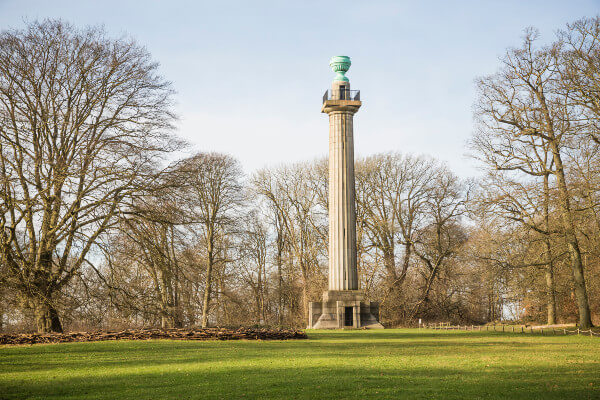National Trust Vision for Ashridge Estate

- Significant increase in visitor numbers in recent years is causing wide-spread damage to the Special Area of Conservation (SAC)
- Plans have been unveiled as part of the long-term strategy to help secure the future of the protected landscape
- Proposals include creating three new visitor hubs and an interim car park to reverse the damage caused by car parking on the grass verges on Monument Drive
- Car parking charges to be introduced across the estate
The National Trust’s Ashridge Estate, which sits within the Chilterns National Landscape (formerly Chilterns AONB) has unveiled plans to protect the long-term future of the estate due to increasing pressure from the large number of visitors that regularly enjoy the 5,000 acre estate.
In recent years significantly more visitors are enjoying the opportunity to explore the ancient woodland, chalk grassland and open commons found at Ashridge Estate, a large percentage of which is covered by the Chiltern’s Beechwood Special Area of Conservation (SAC) resulting in wide-spread damage to the fragile, important and protected habitats, which the conservation charity aims to protect and care for.
In 2021 it was estimated that 1.7 million visitors came to Ashridge Estate and with more than 30,000 new homes planned in the local area in the next 10 years, this number is expected to rise considerably.
Over the bank holiday weekend more than 500 people came to a public engagement event to see and hear the latest updates for the charity’s ‘Protecting Our Roots’ project, a long-term strategic plan to protect the future of Ashridge estate.
Paul Miller, General Manager at Ashridge Estate explains, ‘We need to act now if we are to reverse some of the damage to the precious habitats in our care. At the heart of our vision is an ambition to create three new visitor hubs to help disperse the volume of visitors away from Monument Drive and the main visitor centre area, which is one of the most sensitive parts of the landscape. One of the hubs will see us working with the owners of Pitstone Quarry, which adjoins the estate, with the other two located at Ward’s Hurst Farm and an area of land at Hill Farm.
‘Plans are still being developed for the hubs but could include facilities such as food and drink outlets, toilets and picnic areas as well as opportunities for outdoor accessible experiences including walking, cycling, natural play and education spaces. At Ward’s Hurst Farm we will reintroduce traditional practices like coppicing to restore wildlife rich habitats, while at Hill Farm we will enhance the biodiversity by creating a mosaic of native woodland, wood pasture, scrub and grassland.
‘Pitstone Quarry offers a wonderful opportunity to restore a huge area of rare chalk downland and a freshwater lake for organised wild swimming.’
It’s expected to take around five years until the new hubs are ready to welcome visitors. In the meantime, the immediate priority is to limit further damage to the grass verges either side of Monument Drive that are currently used for car parking. The National Trust plans to create an interim car park on Meadley’s Meadow behind the visitor centre.
Paul explains; ‘Monument Drive is in the heart of the Special Area of Conservation. The soil here is very delicate but becoming badly compacted and eroded, putting the ancient trees that line the drive at risk. We need to take immediate action to prevent further damage. Meadley’s Meadow is already used for additional car parking at peak times, so we plan to formalise this arrangement by putting down a temporary surfaceso it can be used all year round. Once the new visitor hubs are open, the temporary surface will be removed, and the meadow will be restored.’
Paul continues, ‘Our plan is ambitious, and it’s going to take time, but we need to make major changes across the estate if we want to ensure it can still be enjoyed by future generations, whilst balancing the needs of the nature that lives here.
‘The size and scale of Ashridge and the land’s many designations make any changes challenging and complex. We’ve had to make some tough decisions and we understand the changes may be difficult for some, but we’ve been working closely with local authorities, conservation experts and key stakeholders to bring together our plan and ensure it is robust to cope with the pressures it faces now and into the future.
‘We don’t want to stop people visiting Ashridge Estate. This is all about balancing the needs of nature and those that love visiting this landscape. It’s a careful balance to get right, but we believe our long-term plan offers the best solution to provide access to nature and green space, in a way that protects the special biodiversity and habitats located here at Ashridge.’
As well as creating new visitor hubs, car parking charges will also be introduced across the estate.
Paul explains why this change is needed: ‘As a charity, we rely on income from car parking to help fund our essential conservation work. For decades Ashridge has been free to those visiting by car, but looking after somewhere like Ashridge takes a lot of resource, so it’s important we’re able to generate income if we’re to continue to look after this special place and our visitors. Parking will remain free for National Trust members.’
The planning application for the interim car park is expected to be submitted later in the year with planning for hubs expected to start next year. You can find out more and see the latest plans at www.nationaltrust.org.uk/ashridge-protecting-our-roots.

